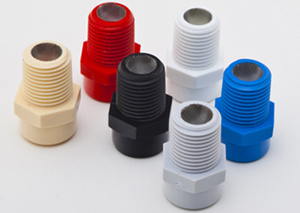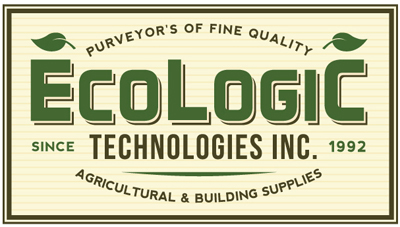Plastic Misting Nozzles – Description, Uses, Applications, Construction, and Other Useful Information.

Misting Nozzles are one of the main components of a misting system. It is the part of the misting system that atomized water comes out of in the form of a spray, or a fine mist, or even a fog
at much higher pressures.
Plastic Misting Nozzles are also referred to as spray nozzles, atomizers, sprayers, misters or even fog nozzles, although the term “fog nozzle” normally refers to a metal nozzle that produces much finer droplets and is designed to operate at higher pressures than the typical plastic misting nozzle.
Misting systems can be used for a variety of recreational and industrial applications. Some of the most common uses include “patio misters” or people cooling, “greenhouse misters” or greenhouse cooling systems. Other uses include kennel and livestock cooling, dust suppression, odor control, mosquito spray systems, produce storage humidification systems, and special effects.
Misting Nozzles are usually small plastic, metal, or even composite fittings, sometimes threaded and sometimes flanged. They have a small orifice in the center where the atomized water exits the nozzle. Better quality “plastic” misting nozzles are normally made from “acetal” due to its wide working temperature range, chemical resistance, and durability.
The plastic misting nozzles are normally rated for 30-250 PSI, while the brass and stainless steel nozzles are rated at 45-1000+ PSI. Always confirm the rating of the nozzle before using it in a pressurized application as not all models are the same. Nozzles that are used at too high a pressure can either shatter or be forced out of the socket and turned into a dangerous projectile.
In fact in some higher pressure applications only metal nozzles with “safety holes” can be used. The safety hole allows the nozzle to be secured to the trunk line with a short length of wire. This prevents the misting nozzles from dislodging and causing damage or injuries. These are normally larger nozzles that are referred to as “impingement nozzles”, or “stainless steel impingement nozzles”.
Plastic Misting Nozzles are frequently used for patio misters, people misters, livestock cooling systems, produce misting systems, meat process room humidification systems, concrete curing, and many other applications.
Although high quality plastic misting nozzles are very durable with good resistance to lime and mineral deposits (especially those made from acetal). Other applications that require a harder, longer lasting, and more chemically resistant nozzle would opt for a nozzle made from stainless steel, brass, or even aluminum.
The metal nozzles, i.e. “fog nozzles” or “brass misting nozzles”, normally have orifices that are made from polycarbonate, stainless steel, or ruby. The core of the brass body nozzles is almost always made from a polycarbonate composite or similar material. And although polycarbonate is very durable and long lasting it is not as chemically resistant or as durable as stainless steel is. So when using chemicals in a misting system it is normally best to choose a nozzle with a brass body, a stainless steel orifice, and a stainless steel core just to be safe. In many occasions a less expensive brass nozzle with stainless steel orifice and stainless steel core will suffice.
A word of advice. If you plan on using anything other than pure water in your misting system, and your reputation depends on the performance of your misting system, then always take the time to open up a nozzle and double check that the core is actually made from stainless steel. If the dealer doesn’t specify what the core is made of then they probably don’t even know what it is and might automatically assume that just because the orifice is stainless steel that the core is also stainless steel. And more often than not that would be a mistake. The bulk of the brass fog nozzles (the standard “swirl” type nozzles) being sold on the market have polycarbonate or plastic cores.
Misting Nozzles are available with a variety of spray patterns as well. Typically people cooling, animal cooling, or greenhouse cooling applications utilize a misting nozzle or fog nozzle with a “full cone” spray pattern or a “conical” spray pattern. Full cone misting nozzles normally produce some of the finest droplets to achieve the highest rates of evaporation.
Both the brass fog nozzles and plastic misting nozzles are available with some type of “anti drip” systems. The plastic nozzles are available with an internal anti drip valve that only allows water through the orifice of the nozzle when there is sufficient pressure to produce a nice spray pattern. If sufficient pressure isn’t available then the valve will close, preventing dripping nozzles caused from too little pressure.
Anti drip systems for the brass and stainless steel misting nozzles are separate parts that are screwed onto the nozzle. The anti drip fog nozzle system consists of a brass or stainless steel body that the nozzle screws into. A spring and rubber ball is inserted into the body before the nozzle is screwed on. When there is sufficient pressure in the line to compress the ball and spring, atomized water can exit the nozzle. When the pressure in the line drops the spring pushes the ball back up and against the top of the fitting blocking the water flow to the fog nozzle.
The most popular thread sizes for the standard plastic nozzles used in many agricultural, cooling, or greenhouse humidification systems are 1/8” national male pipe thread, or 1/8” mnpt for short.
The misting nozzle might be only one small part of a much larger unit, but it is the final part that decides the performance of the entire system.
